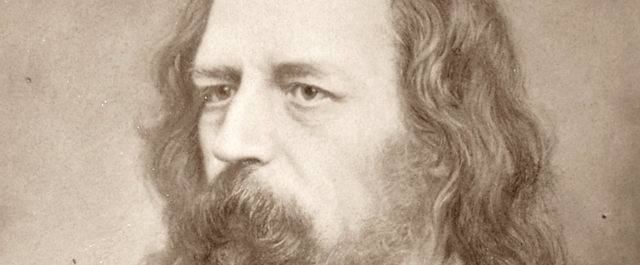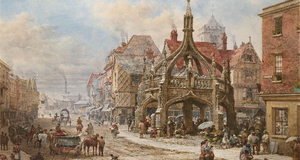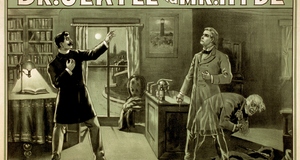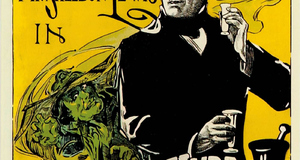Featured Article:The Search for Utopia: Charles Dickens' Hard Times and Alfred Tennyson's Mariana
By
2014, Vol. 6 No. 10 | pg. 2/2 | « Mariana: Antithetical Settings in Romantic PoetryTennyson uses tragic elements to portray the confining interior settings and barren exterior settings in his poem, Mariana, as non-ideal. Mariana’s imprisonment in a confined space exposes her directly to the restrictive nature of interior settings and indirectly to the unkempt “wildness” of exterior settings. Ultimately, Tennyson indicates that neither of these antithetical settings is ideal for Mariana, leaving only the possibility that his conception of the ideal setting lies at an unspecified point between the two extremes. It is reasonable, but merely speculative, to infer that Mariana’s ideal setting necessitates the freedom of mobility between interior and exterior settings. Tennyson suggests that Mariana’s prison is not an ideal setting by isolating it from all natural indications of the passage of time existing outside of it. Evidence that Mariana is languishing in this non-ideal setting prominently includes her repeated use of the word “weary” to describe her own state of being. Tennyson subtly purveys the idea that the passage of time in this “dreamy house” wherein Mariana is imprisoned is disorienting to its occupant, because it shuts her off from all natural indicators which mark the progression of time (l. 61). Although she is aware of “The slow clock ticking,” such evidence of the passage of time nonetheless “did all confound/Her sense” since the physical structure of the house bars her from a broad view of the world external to it (l. 74-77).For example, since Mariana is able to view the external natural world only through her window, she may lose track of the position of the sun in the sky or be unable to see it at various times during the day. Indeed, Tennyson comments that “She could not look on the sweet heaven/Either at morn or eventide,” suggesting that her house may face either the north or the south and thereby prevent her from tracking the sun’s course throughout the day (l. 15-16). This is the most ostensible natural marker of the continual progress of time from present to future. The daily occurrences of which Mariana is most aware are those which occur inside the house or in her memory, as when “the doors upon their hinges creak’d…Old faces glimmer’d thro’ the doors/Old footsteps trod the upper floors” (l. 62-68). The “old faces” and “old footsteps” mark her singularly unnatural passage through time: While time naturally progresses in a forward direction, from the present towards the future, Mariana is reliving the past through memories of old faces and footsteps. This lends her the very singular impression of a woman who has been cut off from the natural forward progression of time, causing her to become ensnared by the past. Consequently, the speed or sloth with which time passes seems to catch her unawares and have a disorienting effect upon her, “confounding” her senses (l. 76). The tragedy of Mariana’s state of exclusion from the forward progression of time is conveyed through her repetition of “I am aweary, aweary/I would that I were dead!” (l. 11-12). The significance of this statement is amplified by the fact that it is her only dialogue in the poem. Her perpetual confinement to this limited and temporally vacuous interior “without hope of change” causes her to wish for death, and induces Tennyson to devote the character’s sole dialogue in the poem to this despairing wish (l. 29). Hughes describes this state poignantly and concisely as Mariana’s “hopeless interiority” (110). Her confinement is, indeed, a “hopelessly” lonely state of being. All of these factors heavily indicate that Tennyson believes that Mariana’s architectural interior setting is not ideal because it impedes her conception of time’s passage. Mariana’s lament that she is “aweary” because she is imprisoned “without hope of change” reveals that her interior setting has temporally isolated her by stripping the future away from her existence. As a result, she is a woman who languishes in memories of “old faces” which belong to the past. Tennyson contrasts the temporal isolation of Mariana’s interior settings with the dilapidation and social isolation of the natural setting immediately exterior to her prison. Tennyson’s description of the physical isolation and dilapidation of the immediate exterior of Mariana’s house identify it as a non-ideal setting. The untamed wildness of this natural exterior facilitates the decay of architectural and horticultural hallmarks of civilization within the poem. For example, Tennyson describes the “blackest moss” which coats the flowerpots and the “rusted nails,” which suggest that the house and garden have fallen into disrepair (l. 1-3). Specifically, they have fallen prey to natural elements and become dilapidated. His observation that “The broken sheds look’d sad and strange” conveys the tragedy of this state of disrepair: The derelict house and grounds represent the suffocation of elements of civilization by unregulated natural forces. This is an eerie and melancholy process of disintegration which involves the breakdown of man-made structures. Consequently, it affects man and civilization adversely. Tennyson also characterizes this exterior setting as barren, noting that “For leagues no other tree did mark/The level waste, the rounding gray” (l. 43-44). The tragic nature of the landscape is also evident in the narrator’s description of the “lonely, moated grange” (l. 8). The natural exterior not only suffocates all traces of civilization, but itself is a “lonely,” isolated wasteland. In this vein, Welch notes that “static time is significant in such well-known poems as ‘Mariana’” because “the landscape as a whole conveys in isolation, sterility, and stasis the condition of Mariana” (198-199). The “isolating” effect of the barren landscape on Mariana is particularly tragic – it emphasizes her status as an outcast existing beyond the periphery of her fellow human beings. Indeed, Mariana herself repeatedly laments that “the night is dreary” and “the day is dreary” (l. 21, 33). This funereal refrain may be attributed to the barrenness of the landscape, the decay of the house and garden, or the lack of human contact in the surrounding exterior. The latter hypothesis is supported by Mariana’s ostensible longing for her brother who “cometh not” to save her (l. 22). Her only hope of deliverance from imprisonment lies with her brother. However, the “loneliness” of the unpopulated grange seems to eradicate any possibility of salvation by human contact. The landscape thereby assumes a singularly hopeless aspect because it is devoid of trees, as well as human beings. Thus, Tennyson suggests that social factors, as well as architectural interiority and ecological exteriority, affect the idealism of a setting. Since the natural exterior setting depicted in Mariana is socially isolated, derelict, and barren, it is decidedly not an ideal setting. Tennyson suggests that the interior setting which comprises Mariana’s prison is not ideal because it bars her from all ostensible signs of the forward progression of time and society. Consequently, she languishes in the haunting memories of her past. Tennyson also demonstrates that the surrounding exterior is not an ideal setting because it visibly chokes all traces of civilization, is characterized by barrenness, and is devoid of human contact. By eliminating these antithetical interior and exterior settings as candidates for Mariana’s ideal setting, Tennyson invites the possibility that the true ideal setting lies between these two extremes. Since Mariana’s tragic state is so clearly defined by confinement, it is reasonable to suggest that an ideal setting is comprised of interior and exterior settings across which there is mobility. Mariana’s isolation also suggests that cohabitation with fellow human beings characterizes an ideal setting. However, Tennyson does not specify the exact nature of Mariana’s ideal setting. ConclusionDickens’ and Tennyson’s idealizing process with respect to setting synthesizes the opposition of two non-ideal antithetical settings with comic and tragic elements. Dickens eliminates urban and rural settings as candidates for the “ideal” setting by demonstrating the alternately tragic and comical ways in which characters fail to thrive in these antithetical settings. Tennyson eliminates Mariana’s interior and immediately exterior settings as candidates for the ideal setting by demonstrating the tragic temporal isolation of the former and the tragic physical barrenness of the latter. Dickens and Tennyson thereby employ the same rhetorical process to suggest that ideal setting fall somewhere between the two comical or tragic extremes presented. In both cases, the identity of the author’s conception of the ideal setting is ultimately unspecified, but may be inferred within the limitations of the two antitheses presented. Remarkably, this idealizing process is potent enough to transcend differences of genre and movement between these two writers. This dual applicability of testifies strongly to its versatility as a rhetorical device. ReferencesBornstein, G. (1971). Miscultivated Field and Corrupted Garden: Imagery in Hard Times. Nineteenth-Century Fiction, 26(2), 158-170. Dickens, C. (2003). Hard Times. London: Penguin. Hazlitt, W., & Carr, F. (1889). Essays of William Hazlitt. London: The Walter Scott Pub. Co. Hughes, J. (2007). Hang There Like Fruit, My Soul: Tennyson's Feminine Imaginings. Victorian Poetry, 45(2), 95-115. Kearns, K. (1992). A Tropology of Realism in Hard Times. English Literary History, 59, 857-881. Mermin, D., & Tucker, H. F. (2002). Victorian Literature, 1830-1900. Fort Worth, TX: Harcourt College Publishers. Raj, P. P. (2012). Hard Times as a Dickensian Dystopia. Rupkatha Journal on Interdisciplinary Studies in Humanities, 4(1), 91-99. Tennyson, A. T., & Day, A. (1991). Alfred Lord Tennyson: Selected Poems. London, England: Penguin Books. Voss, A. (1964). A Note on Theme and Structure in Hard Times. Theoria: A Journal of Social and Political Theory, 23, 35-42. Welch, J. D. (1976). Tennyson's Landscapes of Time and a Reading of "The Kraken". Victorian Poetry, 14(3), 197-204. Suggested Reading from Inquiries Journal
Inquiries Journal provides undergraduate and graduate students around the world a platform for the wide dissemination of academic work over a range of core disciplines. Representing the work of students from hundreds of institutions around the globe, Inquiries Journal's large database of academic articles is completely free. Learn more | Blog | Submit Latest in Literature |



















